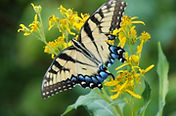pink azalea (Rhododendron periclymenoides)
COMMON NAMES:
pink azalea
wild-honeysuckle
purple-honeysuckle
pinxterbloom
azalea pinxter flower
election-pink
SCIENTIFIC SYNONYMS:
Rhododendron nudiflorum (L.) Torr.
Rhododendron nudiflorum (L.) Torr. var. glandiferum (Porter) Rehder
Rhododendron periclymenoides (Michx.) Shinners var. eglandulosum
Seymour
CONFIRMATION STATUS: Pending confirmation.
TAXONOMY: The currently accepted scientific name for pink azalea is
Rhododendron periclymenoides (Michx.) Schinners. There are no recog-
nized subspecies, varieties, or forms.
NATIVE STATUS: Native, United States.
GENERAL BOTANICAL CHARACTERISTICS: Pink azalea is a low,
erect, deciduous, stoloniferous shrub which grows to 6.0 feet (but usually
smaller) in height. It has open, low branches, often with a crooked stem,
sparse foliage, and forms dense thickets. Twigs are very slender, red-brown
to gray, bristly-hairy; buds are multiple terminal, pointed and yellow-green
to red-brown, flower buds are much larger 1/2 inch long, broadly ovate.
The bark is gray to redddish-brown, becoming finely shreddy. The leaves
are simple, deciduous, alternate, and mostly in clusters at the tips of the
branches. Leaves are ovate, 1 to 3 inches long, pinnately veined, dull green
above and green below with a ciliate margin. The tubular, individual flowers
are borne in small terminal clusters. Flowers are monoecious, very showy,
light pink to violet, 1 1/2 inches long and across, in large clusters appearing
with or just before the leaves in mid-spring. The fruit is an oblong, many-
seeded, woody capsule, 1/4 to 1/2 inch long, with ascending hairs. The cap-
sule splits when ripe, releasing the very tiny, somewhat winged seeds in late
summer.
REGENERATION PROCESS: Pink azalea can reproduce by seed, al-
though details have not been described. It can also regenerate by layering,
sprouting from the root crown, or by sending out horizontal stems that root
at the nodes. Pink azalea seed are probably dispersed by small birds and
mammals.
SITE CHARACTERISTICS: Pink azalea commonly occurs in mixed
deciduous forests along stream bottoms, bogs, shaded mountain sides, and
ravines. Wild honeysuckle flourishes on well-drained acid soils in cool,
moist locations.
SUCCESSIONAL STATUS: Pink azalea is very shade tolerant.
Researchers report that pink azalea produces a majority of its growth
after canopy closure.
SEASONAL DEVELOPMENT: Pink azalea flowering dates are from
March to May. The fruit ripens late in the summer and the seed is dispersed
in the late fall.
GENERAL DISTRIBUTION: Pink azalea grows mostly in the moun-
tainous regions in the eastern United States from southeastern New York
south through the Appalachian Mountains to Georgia. Outlying populations
occur in southern Indiana, Ohio, and Illinois.
SKY MEADOWS DISTRIBUTION:
Shrub specimens can be found on trails marked in red.
Bleak House
Appalachian Trail/Old Trail
South Ridge/North Ridge
Gap Run
Snowden
Woodpecker Lane
Sherman's Mill
Rolling Meadows/ Lost Mountain
Fish Pond
Only one specimen of pink azalea has been found in Sky Meadows State
park. This specimen is small and very inconspicuous (except when it is in
bloom), and is situated on a highly traversed trail. Because it is very vul-
nerable to disturbance, its specific location is not indicated.
HABITAT TYPES AND PLANT COMMUNITIES: Pink azalea com-
monly occurs in mixed deciduous forests. Some common tree associates
of pink azalea are eastern hemlock (Tsuga canadensis), pitch pine (Pinus
rigida), blackgum (Nyssa sylvatica), ironwood (Ostrya virginiana), oak
(Quercus spp.), and birch (Betula spp.). Some common understory associ-
ates include rosebay rhododendron (Rhododendron maximum), flowering
dogwood (Cornus florida), mountain laurel (Kalmia latifolia), highbush
blueberry (Vaccinium corymbosum), and maple-leaved viburnum
(Viburnum acerifolium).
IMPORTANCE AND USES: Pink azalea provides cover for a variety of
birds and mammals.
Pink azalea affords erosion control and steep watershed protection in the
mountains of the eastern United States.

Park Activities
Calendar of Events
Volunteer Programs
Sky Meadows Park
Location
Geography
Habitats
Trails
Visiting Park
Crooked Run Valley
Special Projects

